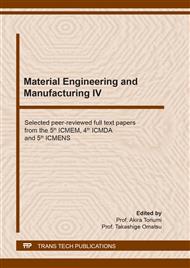p.116
p.125
p.133
p.139
p.145
p.151
p.159
p.166
p.173
Mechanical Characterization and Fracture Analysis of Epoxy Resin Composites Reinforced with Quasi-Unidirectional Salago Fibers
Abstract:
The good environmental effect and possible cost reduction which can be achieved by reinforcing natural fibers in composites while improving some properties led to the development of these materials in various fields. In terms of mechanical properties of composites with natural fibers, both fiber loading and their orientation in the matrices are important factors. In this research work, the effects on the mechanical properties of reinforcing quasi-unidirectional salago fiber in epoxy resin were investigated. Varying alkaline treated fiber contents of 5 %, 10 % and 15 % by weight were characterized through tensile, flexural and impact tests. Fracture analysis after mechanical testing was done with the aid of optical microscopy. As the fiber weight content increases, results revealed enhancements on tensile strength, modulus of elasticity, flexural modulus and impact strength. Overall, the 15 wt. % fiber loading obtained the highest mechanical properties with average tensile and Izod impact strengths of 89.2 MPa and 137 J/m, respectively.
Info:
Periodical:
Pages:
145-150
Citation:
Online since:
September 2021
Authors:
Keywords:
Price:
Сopyright:
© 2021 Trans Tech Publications Ltd. All Rights Reserved
Share:
Citation:


